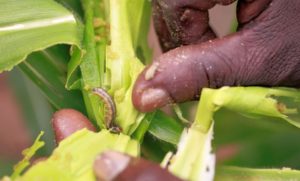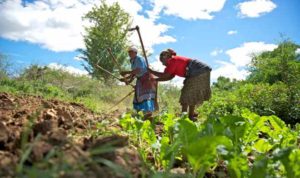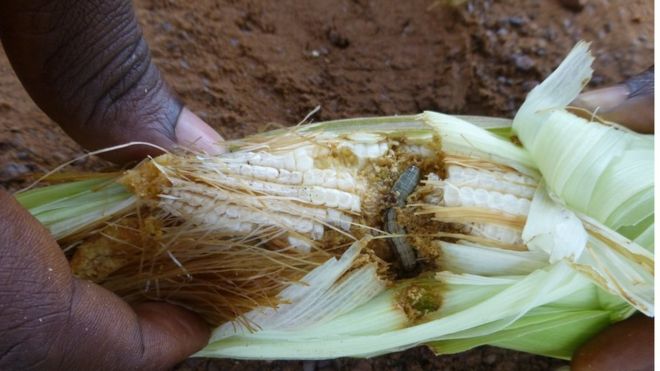By Winnie Kamau
The fall armyworm (FAW) is a native pest to the Americas and was first reported on the Southern part of Africa in January 2016 following subsequent investigations which have revealed the pest in nearly all of the continent. FAW as it now famously known has caused extensive damage especially to maize fields and to a lesser degree sorghum and other crops.
The International Maize and Wheat Improvement Center (CIMMYT) launched the guide dubbed Fall Armyworm in Africa: A Guide for Integrated Pest Management which indicates that over 30countries have identified the pest within their borders including Island countries of Cape Verde, Madagascar, Sao Tome and Principe and Seychelles.
The Scientists say the best evidence to date suggests that the FAW type introduced into Africa is the haplotype originating from South Florida in the USA and the Caribbean but the number of introductions is not known at present but anecdotal observation and the response of single-gene genetically modified Bt maize in South and East Africa suggests it has been present for at least several years. The generally hospitable agroecological conditions for FAW in Sub Saharan Africa, suggest that FAW will establish itself as an endemic, multigenerational pest in Africa.

Practices for Smallholders that Need Further Research Evidence
This includes the application of sugar water to maize foliage. Though in some cases this practice has been recommended, efficacy, practicality at scale, and cost have to be established.
The placement of ash/sand/soil/chili powder in maize whorls. Though all of these practices
are being tried by some smallholders in Africa, additional research evidence is required on the efficacy and scalability, as well as the mechanism behind their possible effect on FAW.
Deep Tillage is said it can kill pupae in the soil. However, soils are normally tilled before FAW arrives in a field; tilling may, therefore, cause more harm than good, by reducing biological activity and increasing soil degradation while contributing relatively little to FAW control due to the asynchronous timing of the intervention with the pest population cycle. Its effect is therefore inconclusive and should be investigated further.
Recommended Practices to Control FAW
Based on a review of available evidence, the 7 recommended low-cost cultural practices and landscape management options are currently recommended for control of FAW. With the exception of the “Push-Pull” approach, for which experimental evidence exists to suggest efficacy against FAW in an African context, many of these measures represent generic best crop and landscape management practices for pest control and have not been specifically validated for FAW in Africa and are low cost to implement.
The first method includes Planting at the recommended time. Plant nutrition is efficient as good fertilization reduces plant damage by increasing plant health and defense against pests. Another one is intercropping with compatible companion crops or fertilizer trees.
Conservation Agriculture comes highly recommended and said to be more effective. Increased ground cover by use of a range of cover crops that are effective as a trap. Another one is Hedge grows and Live Fences are usually less infested with pest due to biological control agents like birds. Last but not least is the Enhancing Agroforestry system at the landscape level to help create biodiversity and biological pest control.

Why FAW is Destructive
A number of characteristics and factors make FAW a more devastating pest than many others.
It is known FAW is capable of feeding on over 80 different crop species, making it one of the most damaging crop pests. While FAW has a preference for maize, the main staple of many countries in Africa, it can also affect many other major cultivated crops, including sorghum, rice, sugarcane, cabbage, beet, groundnut, soybean, onion, cotton, pasture grasses, millets, tomato, potato, and cotton.
It is also known that FAW spreads quickly across large geographic areas. Like other moths in the genus Spodoptera, FAW moths have both a migratory habit and a more localized dispersal habit. In the migratory habit, moths can migrate over 500 km (300 miles) before it lays its eggs. When the wind pattern is right, moths can move much larger distances: for example, a flight of 1,600 km from the southern U.S. state of Mississippi to southern Canada in 30 hours has been recorded
FAW can persist throughout the year. In most areas of North America, FAW arrives seasonally and then dies out in cold winter months, but in much of Africa, FAW generations
will be continuous throughout the year wherever host plants are available, including off-season and irrigated crops, as the climatic conditions are favorable. Although the patterns of population persistence, dispersal, and migration in Africa are yet to be determined, conditions in Africa, especially where there is a bimodal rainfall pattern, suggest that the pest can persist throughout much of the year.

The impact of FAW
The impact of FAW has been immense across Africa due to its rapid spread and distinctive ability to inflict widespread damage across multiple crops, FAW poses a serious threat to the food and nutrition security and livelihoods of hundreds of millions of farming
households in Afric particularly when layered upon other drivers of food insecurity.
In Southern Africa, for example, the 2016-17 FAW outbreak arrived just as households in the region were still reeling from the 2015-16 El Niño-induced drought, which affected an estimated 40 million people. The potential economic impacts of FAW on agricultural productivity across and beyond Africa are substantial:
Based on an evidence note published by the Centre for Agriculture and Bioscience International (CABI) in September 2017, in the absence of proper control methods, FAW has the potential to cause maize yield losses of 8.3 to 20.6 M metric tons per year, in just 12 of Africa’s maize- producing countries.
Several seed companies in Africa have reported significant damage to their maize seed
production fields over the past year, potentially impacting both the availability of seed to
farmers over the coming growing seasons and the economic viability of Africa’s emerging
private seed sector.
According to the guide the establishment of FAW populations in Africa has broader implications for global agriculture, as it also increases the risk that the pest will further migrate to Europe with Scientists speculating, possibly via North Africa and Egypt) and Asia possibly via African countries on the east coast, such as Ethiopia.
In the management of FAW can result in several critical problems, one being substantial environmental and human health issues, arising from both the initial application of
hazardous chemicals and continued exposure to pesticide residues on consumed produce or
in the production environment.














